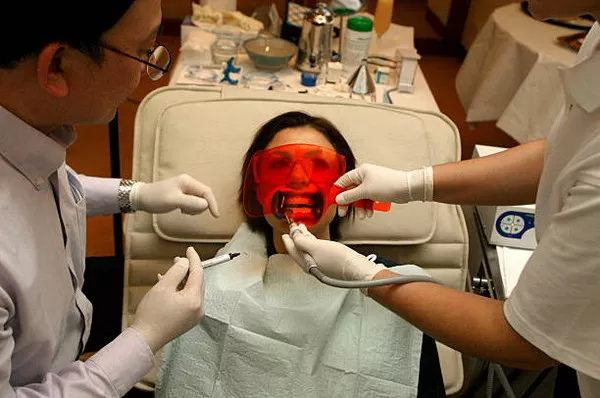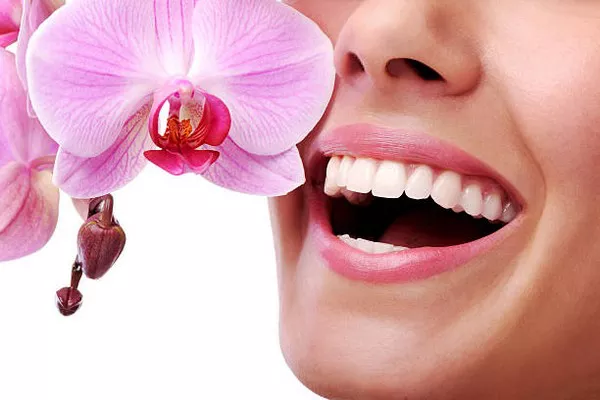Whitening strips have become a popular at-home solution for achieving a brighter smile. These strips consist of a thin plastic film containing a whitening gel. The active ingredient in most whitening gels is hydrogen peroxide, ranging from 5% to 15% concentration in the US. This chemical agent works by breaking down stains on the teeth, which leads to a lighter, whiter appearance.
Hydrogen peroxide is a bleaching agent that penetrates the enamel and dentin of the teeth to remove stains. The convenience and affordability of whitening strips make them a favored option for many seeking cosmetic dental improvement without the need for professional intervention.
Surface Stains
Whitening strips are effective in removing extrinsic stains from the tooth’s enamel. Extrinsic stains are those that form on the outer surface of the teeth. These stains are usually caused by dietary and lifestyle factors such as consuming coffee, tea, red wine, and tobacco products. Over time, these substances can leave discolorations on the enamel, making the teeth appear yellow or brown.
The peroxide in the whitening strips breaks down the chromogens (color-causing molecules) on the enamel, effectively lightening these surface stains. Regular use as directed can gradually restore the natural whiteness of the teeth, leading to a noticeably brighter smile.
Intrinsic Stains
Whitening strips cannot remove intrinsic stains, which reside underneath the enamel in the dentin and beyond. Intrinsic stains are typically deeper discolorations within the tooth structure. These can result from a variety of factors, including:
Aging: Over time, the inner part of the tooth (dentin) naturally yellows.
Trauma: An injury to the tooth can cause discoloration as the tooth reacts to the injury.
Certain Medications: Antibiotics like tetracycline can cause intrinsic staining if taken during tooth development.
Excessive Fluoride: High fluoride levels during tooth development can lead to a condition called fluorosis, which manifests as white spots or streaks on the teeth.
Since intrinsic stains are embedded within the tooth structure, surface treatments like whitening strips are ineffective against them. These deeper stains often require professional treatments such as in-office bleaching, veneers, or bonding.
see also: How much does permanent teeth whitening cost?
Enamel Damage and Sensitivity
Risk of Enamel Damage
Whitening strips containing bleaching ingredients like hydrogen peroxide can potentially cause damage to the tooth’s enamel. Enamel is the hard, protective outer layer of the tooth. It is vital for protecting the underlying dentin and pulp from decay and damage.
Prolonged use of whitening strips or the use of strips with high concentrations of hydrogen peroxide can lead to enamel erosion. Enamel erosion is the gradual wearing away of the enamel, which can lead to several dental problems, including increased susceptibility to cavities and tooth decay.
The mechanism of enamel erosion involves the breakdown of the mineral structure of the enamel by the acidic nature of hydrogen peroxide. Although the enamel is the hardest substance in the human body, it is not immune to chemical wear. When the enamel wears away, it cannot regenerate, making it crucial to use whitening products carefully and under appropriate guidance.
Sensitivity
Some people experience tooth sensitivity when using whitening strips. Tooth sensitivity is a common side effect of whitening treatments and occurs when the peroxide penetrates the enamel and reaches the dentin, which contains tiny tubules leading to the tooth’s nerve center (pulp).
This can cause irritation and an increased reaction to hot, cold, or sweet stimuli. Sensitivity can range from mild discomfort to significant pain, depending on the individual’s sensitivity level and the concentration of the whitening agent used.
However, many users whiten their teeth without experiencing significant damage or sensitivity. Factors influencing sensitivity include the individual’s baseline tooth sensitivity, the concentration of peroxide, the duration of each treatment session, and the overall treatment period.
Safe Usage
Correct usage is essential to minimize the risks associated with whitening strips. Most over-the-counter strips are safe when used as directed. Here are some key guidelines for safe usage:
Follow Instructions: Always adhere to the manufacturer’s instructions regarding application time and frequency.
Limit Use: Do not exceed the recommended duration of treatment. Typically, whitening treatments should not be used for more than two weeks at a time without consulting a dentist.
Monitor Sensitivity: If you experience increased sensitivity, reduce the frequency of use or take a break from the treatment.
Consult Your Dentist: Before starting any whitening regimen, it’s wise to discuss it with your dentist, especially if you have existing dental issues such as cavities, gum disease, or worn enamel.
Your dentist can provide personalized advice based on your oral health status and recommend alternative treatments if whitening strips are not suitable for you.
see also: How much does boutique whitening cost?
Pros and Cons of Whitening Strips
Pros
Convenient: Whitening strips are easy to use at home. They fit into busy schedules without the need for lengthy dental appointments.
Affordable: Compared to professional whitening treatments, whitening strips are relatively inexpensive and widely accessible.
Gradual Whitening: They can gradually lighten teeth by a shade or two, allowing for a more natural progression and making it easier to control the level of whitening achieved.
Non-Invasive: Whitening strips are non-invasive and do not require any physical alteration to the tooth structure.
Variety: There are various formulations available, catering to different needs such as sensitive teeth or faster results.
Cons
Enamel Risk: There is a potential risk of enamel damage with prolonged or improper use. Overuse can lead to irreversible enamel erosion.
Limited Effect on Intrinsic Stains: Whitening strips are ineffective against intrinsic stains. They can only address surface discolorations, leaving deeper stains untouched.
Sensitivity: Some users may experience tooth sensitivity during and after treatment. This can be uncomfortable and may deter some individuals from continuing the treatment.
Temporary Results: The whitening effects of strips are not permanent. Regular use is necessary to maintain results, which can lead to increased risk of enamel damage over time.
Uneven Whitening: The fit of the strips may not cover all teeth uniformly, leading to uneven whitening results. This can be particularly noticeable on teeth that are more prominently stained.
Conclusion
Whitening strips offer a convenient and affordable solution for achieving a brighter smile by effectively removing extrinsic stains on the enamel. However, they come with potential risks, including enamel damage and tooth sensitivity, particularly with improper use. While they are not effective against intrinsic stains, they can provide noticeable improvement in the color of your teeth when used correctly.
For safe and effective use, it is crucial to follow the manufacturer’s instructions and consult with a dentist to ensure that whitening strips are appropriate for your dental health. Balancing the benefits and potential drawbacks, whitening strips remain a popular choice for those seeking a simple and accessible method to enhance their smile at home.
FAQs about Teeth Whitening and Enamel Health
1. How to whiten teeth without damaging enamel?
To whiten your teeth without damaging enamel, consider these safe and effective methods:
Professional Whitening Treatments: Dentists offer treatments that are specifically designed to minimize enamel damage while effectively whitening your teeth.
Over-the-Counter Whitening Products: Choose products with lower concentrations of hydrogen peroxide or carbamide peroxide. Follow the instructions carefully to avoid overuse.
Whitening Toothpaste: Use toothpaste containing mild abrasives and chemical agents like baking soda or activated charcoal to gently remove surface stains.
Natural Remedies: Brush with baking soda or use hydrogen peroxide in a diluted form (as a mouthwash) occasionally. However, these should be used sparingly to avoid enamel erosion.
Maintain Oral Hygiene: Regular brushing and flossing, combined with professional cleanings, can help keep your teeth white and healthy without the need for aggressive whitening treatments.
2. What whitening strips don’t hurt your enamel?
Some whitening strips are formulated to be gentler on enamel while still providing effective results. Look for products that:
Contain Lower Peroxide Levels: Strips with lower concentrations of hydrogen peroxide or carbamide peroxide are less likely to cause enamel damage.
Are Dentist-Recommended: Products like Crest 3D White Gentle Routine or Sensodyne True White may be gentler on sensitive teeth and enamel.
Include Desensitizing Agents: Some strips are designed with ingredients that help reduce sensitivity, such as potassium nitrate.
Have Shorter Application Times: Strips that require shorter wear times can reduce the risk of enamel damage and sensitivity.
3. Does enamel grow back after whitening?
No, enamel does not grow back once it is worn away or damaged. Enamel is the hard, protective outer layer of your teeth, and unlike other tissues in the body, it does not regenerate. Therefore, it’s crucial to take steps to protect your enamel:
Use Fluoride: Fluoride can help remineralize and strengthen existing enamel.
Avoid Acidic Foods and Drinks: Reduce consumption of acidic foods and beverages that can erode enamel.
Use Gentle Whitening Products: Opt for whitening products that are less abrasive and have lower concentrations of bleaching agents.
Maintain Good Oral Hygiene: Brush with fluoride toothpaste and use a soft-bristled toothbrush to avoid additional wear on your enamel.
4. How do I know if my enamel is gone?
Signs of enamel loss can include:
Increased Sensitivity: You may experience more sensitivity to hot, cold, or sweet foods and drinks.
Discoloration: Enamel loss can lead to yellowing of the teeth, as the underlying dentin becomes more visible.
Rough or Uneven Edges: Teeth may feel rough or have jagged edges as enamel wears away.
Transparency: The edges of your teeth may start to look more transparent.
Increased Tooth Decay: Enamel protects your teeth from decay, so if it’s eroded, you might experience more cavities.
You Might Be Interested In





























